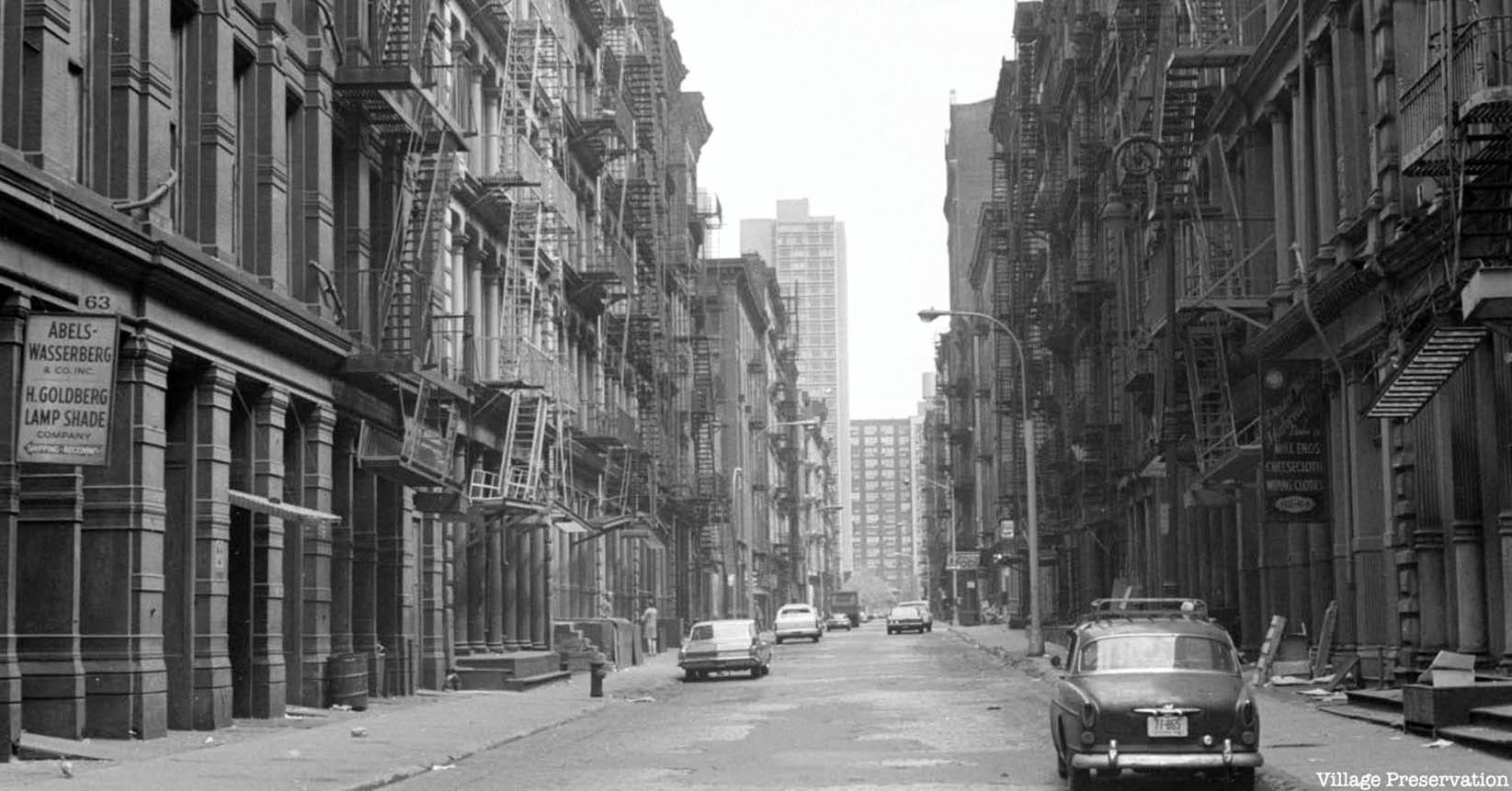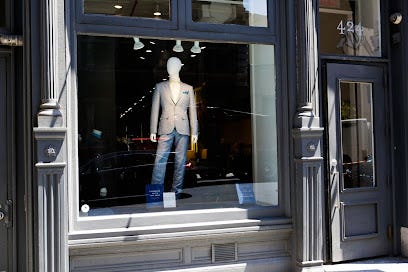 Green Street in 1969
Green Street in 1969
The first loft I lived in was on the north side of Broome Street, between Crosby and Lafayette. I sublet it for the summer of 1969 from an artist by the name of Jack Whitten. It was on the second floor. Up the stairs was a toy factory where they made children’s toys from steel sheets, painted and folded and held together by little tabs that fit into slots. You could hear them up there, hammering the stuff when something didn’t fit, and boxing it up, and occasionally I’d run across one of the workers carrying a cardboard box containing either the sheet steel the things were made of on his way upstairs, or the completed toys, like fire engines and dump trucks in new cardboard boxes on his way downstairs.
When you opened the door, you walked into Jackie’s studio at the front of the loft. Huge windows, bright with south light, were to your right, and to your left was a three-quarter wall and another door leading into the loft’s living space in the back. Lofts in Soho had to be divided that way in those days, because building inspectors would prowl the neighborhood at night looking for lights on in the windows. The three-quarter wall and using table or floor-standing lamps with low wattage bulbs solved that problem. You could have every light in the living space of the loft on at night, and from the street, you couldn’t see even a weak glow from them. Part of the reason was the glass in the windows, which had been etched by a hundred years of coal smoke and truck exhaust and plain old New York City dirt. You could see through them, but Broome Street was slightly blurry. Not that there was much to see out there. Down the street on the other side of Lafayette was a gun store, with a sign hanging outside in the shape of a revolver, that sold exclusively to cops, whose headquarters building was a half-block away on Centre Street. Filling the block between Broome and Grand Streets, it was a grand, dome-topped structure with limestone columns and a pediment above the entrance about half way down the block.
There wasn’t much to see down in Soho in those days. Block after block looked pretty much like the photo of Greene Street above, taken in 1969, probably on a weekend, because there aren’t any delivery trucks in evidence. That’s what you saw during the day in Soho: box trucks picking up bundles of rags and cubes of cardboard, compressed in huge machines and held together with metal strapping, being loaded into trucks. Or boxes of the stuff they made in the lofts down there back then. In the photo, you can see a sign for H. Goldberg Lamp Shade Company, and above it, a sign for Abels-Wasserberg & Co. Inc, that made something else. Could have been mannequins. There were multiple factories that made the mannequins uptown department stores used to display women’s and men’s clothing. Once I walked past a loft building on Broadway, and the door was open. Inside, it might have looked like a meeting of a downtown nudist colony, except for the fact that nobody had genitals.
I used to wonder what other stuff was made down there in Soho, and then one day in 1972, after I had rented my loft at 124 West Houston Street, I learned. We had a kitchen right in the front, and two long rows of cast iron light fixtures hanging from the 16 foot ceilings of the loft. We could have every light in the place blazing and we wouldn’t get evicted because the building had an AIR – Artist in Residency — sign next to the front door, meaning the zoning board had authorized a COO, or certificate of occupancy allowing for artists to live and work in the building’s lofts.
I’ll get to the hanging lights in a minute. On the day in question, the hot water faucet in the little bathroom in the far left corner of the back of the loft began to leak. It wasn’t a small leak. Something had to be done. So, I turned off the water supply pipes under the sink and used a crescent wrench to take the faucet apart. When I got the hot water valve out, I could see why it was leaking so badly.
The rubber washer was completely missing. The only thing holding back the water when you turned it off was a little brass cup with the brass screw that held the missing washer in place. I took the valve and walked down the block to a hardware store that stood for years at the corner of Houston Street and LaGuardia Place and went up to the service desk and asked them if they had a replacement. Made sense, right? The faucet had been installed one block away. They must have gotten it from the closest hardware store.
“Nope, you’re going to have to see Benny Thompson on Lafayette for that one. Number 173, almost to Grand. Can’t miss it.”
There was another hardware store on West Broadway, so not wanting to walk the 10 blocks all the way down to Lafayette and Grand, I stopped there. The guy at the desk took the valve, studied it for a moment and said, “We don’t carry it. You can find it at Benny Thompson’s, though. A few blocks from here, down on…”
I interrupted him: “Lafayette. I know.”
“Tell him Jimmy said hi if you see him,” the hardware store guy said.
On I trudged, down sidewalks made of huge slabs of Pennsylvania bluestone that I learned recently was probably quarried within a short drive of where I’m writing this. Sidewalks all over the city, in Brooklyn Heights and Prospect Park and SoHo and Greenwich Village, were made with slabs of bluestone the size of dining room tables. The bluestone, which started its life a shade of blue-black after decades of being walked on by leather-soled shoes and boots and backed over by truck tires and dropped on by all manner of wood and steel and cardboard containers, was now a dark charcoal color, almost black. The single-stepped entrances to lofts were made of bluestone, so were the loading docks that weren’t made of thick, welded steel plate, cast with little triangles to make it less slippery.
I passed another hardware store when I cut across Spring Street and turned south on Lafayette. Ahead of me I saw a couple of men sitting on folding metal chairs outside a loft building as I neared the corner of Grand Street. I looked for a number on a building and not finding one, asked one of the men where Benny Thompson’s was.
“Right over there,” one of them said, pointing across the street. “Fifth Floor.” I could just barely make out “173” on a sticker affixed to a street level window. Inside, I lifted the gate to a freight elevator, closed it, and cranked the handle slowly to the right until the elevator began to climb upward. I passed the second floor, third and fourth floors, and slowed the elevator as the side of the shaft read “Five,” stopping when I saw the lift gate. It was a huge loft, nearly a half-block long, and from an area I couldn’t see, I could hear machines whirring and grinding and the banging of some kind of stamping machine.
A guy appeared and I asked if this was Benny Thompson’s place. He said, “I’m Benny. Whatcha need?” I held out the little brass valve. He barely glanced at it before pointing to a wheeled canvas basket. “Over there. Take whatever you need.” I looked in the basket, that had to be three feet on a side and three feet deep. It was filled with the exact brass valves I was looking for, which were being manufactured right there in the big loft. I grabbed a couple of them and asked him how much. “Seventy-five cents okay with you?” he asked. “For one?” I asked, holding the valve in my hand. “Gimme a dollar and take three,” he answered.
So, I did, I gave him a dollar and stuck three of the brass valves, complete with their rubber washers, in my pocket, got on the freight elevator and made my way back down to the street.
Walking down Grand Street on my way back to the loft, I passed the lighting store where I had found smoked-glass globes for the fixtures in the loft. They were huge things, and like the brass valve, hard to find. I went into every lighting store on the Bowery before being directed to the place on the corner of Grand and Crosby. It was a dusty storefront filled with every kind of light fixture and lamp and lampshade and globe you could think of. When I asked the guy who owned the place if he had any 12-inch globes with openings for six and three-quarter fittings, he called to his wife in the back, “Honey, don’t we have some of those six and three-quarter globes down in the basement?” She waved to me to follow her down a long set of stairs, and then down another into the second basement. Along one wall were a bunch of crumbling cardboard boxes holding 12 inch globes with six and three-quarter openings. “How many do you need, hon?” she asked. “A dozen,” I answered. “Give me a hand and we’ll carry them upstairs,” she said.
So, I did. Her husband asked her how much they charged, and she said it had been so long since they sold one, she couldn’t remember. “Seventy-five cents okay with you?” he asked me. I peeled off nine one dollar bills and asked him if he could hold the globes while I went and got the 1964 Pontiac Bonneville Grand Prix I was driving at the time. I got the car, and between the passenger seat, back seat and trunk, so they helped me load up, and we managed to fit all 12 of the globes into it and I drove back to Houston Street.
I never knew if the price went up for the brass valves because the one I installed in the faucet lasted for five years, and the next one lasted just as long, so I didn’t need to go back to Benny Thompson’s for a new supply. I wiped out the lighting store’s supply of 12 inch smoked-glass globes with six and three-quarter openings, so the price couldn’t go up on those either.
You walked bluestone sidewalks through Soho back then. I’ve looked at recent photos of West Broadway and Mercer and Wooster Streets, and some of the old sidewalks are still there. They wash them with soap and water these days, so they’ll look good for the customers of places like Zara, which sells expensive women’s wear, and 12th Tribe, which sells reasonably priced women’s kimonos and maxi dresses and jump suits, and Indochino, a men’s store that sells men’s suits and pants and shirts from a storefront at 424 West Broome Street, right downstairs from where I lived for a summer in Jackie Whitten’s illegal loft.
New York is a different place today. The sidewalks on Broome Street are concrete now, and the storefront at 424 looks like this:
